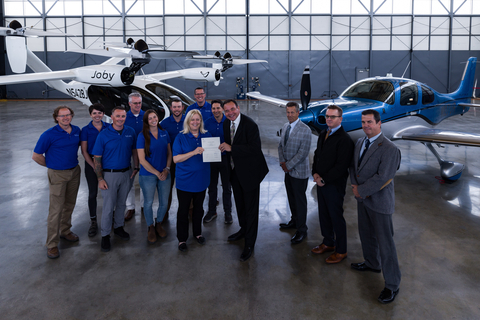- Part 135 Air Carrier Certificate received ahead of schedule, initially targeted for second half of 2022
- Certification allows Joby to operate aircraft commercially
- Joby will use conventional aircraft to refine systems and procedures in advance of launching eVTOL service targeted for 2024
Joby Aviation, Inc. (NYSE: JOBY), a California-based company developing all-electric aircraft for commercial passenger service, today announced the Company has received a Part 135 Air Carrier Certificate from the Federal Aviation Administration, allowing Joby to begin on-demand commercial air taxi operations.
This press release features multimedia. View the full release here: https://www.businesswire.com/news/home/20220526005087/en/

Joby’s air operations team pictured receiving the company’s Part 135 Air Carrier Certificate from the FAA’s San Jose Flight Standards District Office. (Photo: Business Wire)
Joby received the certification ahead of schedule, with completion of the process originally expected in the second half of 2022. The five-stage process included the submission of more than 850 pages of manuals for approval and required Joby’s initial cadre of pilots to demonstrate mastery of the Company’s procedures and training under FAA observation.
The Part 135 Air Carrier Certificate is one of three FAA approvals required for Joby to operate its revolutionary electric vertical take-off and landing (eVTOL) aircraft as an air taxi service in cities and communities across the United States, alongside a Type Certificate and a Production Certificate.
Bonny Simi, Head of Air Operations and People at Joby, and one of the Company’s FAA-approved pilots, stated: “The procedures we’ve prepared lay a foundation for our future eVTOL operations. Over the coming months, we will use our Part 135 certificate to exercise the operations and customer technology platforms that will underpin our multi-modal ridesharing service, while also refining our procedures to ensure seamless journeys for our customers."
“Receiving this certificate ahead of schedule is a testament to the incredible dedication and hard work of our team,” added Simi.
Once Joby receives a type certificate for its eVTOL aircraft, the Company will complete the FAA review process to add the new aircraft type to its existing air carrier certificate. Pilots for the Company’s future aerial ridesharing service, expected to launch in 2024, will have the benefit of flying an environmentally-friendly aircraft on a reliable work schedule, ending each shift in their home city.
Joby previously announced a partnership with CAE, a global leader in aviation training, to develop and qualify flight simulation training devices that Joby will use to train commercially-rated pilots to fly its eVTOL aircraft.
Joby’s all-electric aircraft is designed to transport a pilot and four passengers up to 150 miles on a single charge at speeds of up to 200 mph. Joby recently announced the results of acoustic testing with NASA, which confirmed the aircraft hit the Company’s target for low noise emissions during take-off and landing as well as overhead flight.
ABOUT JOBY AVIATION
Joby Aviation, Inc. (NYSE: JOBY) is a California-based transportation company developing an all-electric vertical take-off and landing aircraft which it intends to operate as part of a fast, quiet, and convenient air taxi service beginning in 2024. The aircraft, which has a maximum range of 150 miles on a single charge, can transport a pilot and four passengers at speeds of up to 200 mph. It is designed to help reduce urban congestion and accelerate the shift to sustainable modes of transit. Founded in 2009, Joby employs more than 1,000 people, with offices in Santa Cruz, San Carlos, and Marina, California, as well as Washington, D.C. and Munich, Germany. To learn more, visit www.jobyaviation.com.
Forward Looking Statements
This presentation contains “forward-looking statements” within the meaning of the “safe harbor” provisions of the Private Securities Litigation Reform Act of 1995, including but not limited to, statements regarding the development and performance of our aircraft, the growth of our manufacturing capabilities, our regulatory outlook, progress and timing; our business plan, objectives, goals and market opportunity; and our current expectations relating to our business, financial condition, results of operations, prospects, capital needs and growth of our operations. You can identify forward-looking statements by the fact that they do not relate strictly to historical or current facts. These statements may include words such as “anticipate”, “estimate”, “expect”, “project”, “plan”, “intend”, “believe”, “may”, “will”, “should”, “can have”, “likely” and other words and terms of similar meaning in connection with any discussion of the timing or nature of future operating or financial performance or other events. All forward looking statements are subject to risks and uncertainties that may cause actual results to differ materially, including: our ability to launch our aerial ridesharing service and the growth of the urban air mobility market generally; our ability to produce aircraft that meet our performance expectations in the volumes and on the timelines that we project, and our ability to launch our commercial passenger service beginning in 2024, as currently projected; the competitive environment in which we operate; our future capital needs; our ability to adequately protect and enforce our intellectual property rights; our ability to effectively respond to evolving regulations and standards relating to our aircraft; our reliance on third-party suppliers and service partners; uncertainties related to our estimates of the size of the market for our service and future revenue opportunities; and other important factors discussed in the section titled “Risk Factors” in our Annual Report on Form 10-K, filed with the Securities and Exchange Commission (the “SEC”) on March 28, 2022, and in future filings and other reports we file with or furnish to the SEC. Any such forward-looking statements represent management’s estimates and beliefs as of the date of this presentation. While we may elect to update such forward-looking statements at some point in the future, we disclaim any obligation to do so, even if subsequent events cause our views to change.
View source version on businesswire.com: https://www.businesswire.com/news/home/20220526005087/en/
Contacts
Investors:
investors@jobyaviation.com
+1-831-201-6006
Media:
press@jobyaviation.com






